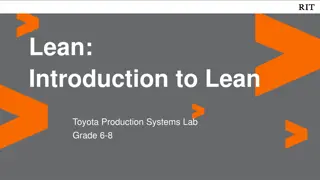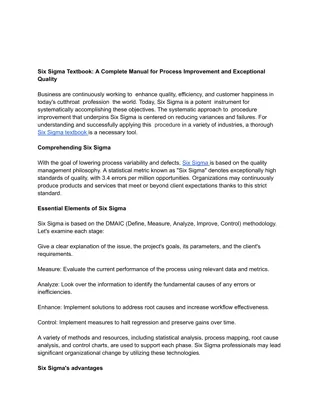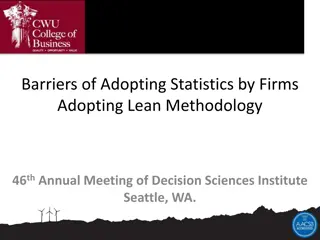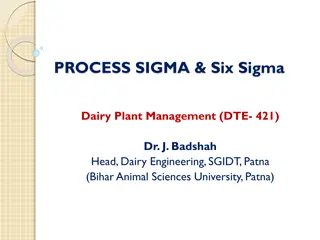Understanding the Key Principles of Six Sigma
Six Sigma is a methodology focused on process improvement by identifying and removing causes of defects in manufacturing processes. It emphasizes empirical and statistical methods to enhance quality, reduce costs, increase customer satisfaction, and boost profits. The goal is near perfection in meeting customer requirements, achieved through disciplined use of data and statistical analysis. A six sigma process aims for 99.99966% defect-free products, ensuring exceptional quality standards.
Download Presentation

Please find below an Image/Link to download the presentation.
The content on the website is provided AS IS for your information and personal use only. It may not be sold, licensed, or shared on other websites without obtaining consent from the author. Download presentation by click this link. If you encounter any issues during the download, it is possible that the publisher has removed the file from their server.
E N D
Presentation Transcript
Six Sigma? It is a set of techniques and tools for process improvement. Introduced by engineer Bill Smith at Motorola in 1986 Jack Welch made it central to business strategy at General Electric in 1995
Six Sigma Six Sigma seeks to improve the quality of the output of a process by: Identifying and removing the causes of defects and minimizing variability in manufacturing processes. Six Sigma uses a set of quality management methods Mainly empirical & statistical methods to create a special infrastructure of people within the organization, who are experts in these methods.
Six Sigma continued EMPIRICAL: A collective term for the knowledge or source of knowledge acquired by: means of the senses particularly by observation and experimentation. STATISTICAL METHODS: Methods used in the: collection, analysis, interpretation, presentation, and organization of data
Six Sigma: Targets Reduce process cycle time Reduce pollution Reduce costs Increase customer satisfaction Increase profits
Six Sigma con. A goal of near perfection in meeting customer requirements A sweeping change of efforts to position a company for: greater customer satisfaction profitability and competitiveness A system for achieving, sustaining and maximizing business success; uniquely driven by disciplined use of facts, data, and statistical analysis diligent attention to managing, improving and reinventing business processes Source: The Six Sigma Way by Pande, Neuman and Cavanagh
Six Sigma continue Sigma rating indicates: the yield or the percentage of defect-free products it creates. A six sigma process is one in which 99.99966% of all opportunities to produce a product or its feature are statistically expected to be free of defects 6 Means 3.4 defects per million opportunities It is by-word for the manufacturing, engineering and management practices
Is 99% Quality Good Enough? 25,000 checks will be deducted from the wrong bank accounts in the next 60 minutes. 12 babies (after delivery) will be given to the wrong parents each day. 25,000 incorrect drug prescriptions will be written in the next 12 months.
Six Sigma Quality DPMO Defects Per Million Opportunities Objective of Six Sigma quality is to have: 3.4 defects per million opportunities! 2 Sigma 3 Sigma 4 Sigma 5 Sigma 6 Sigma 308540 66803 6200 233 3.4
Is Six Sigma Realistic? Sigma 6( 3,4 ppm) Best in Class Sigma 5: 333ppm Sigma 4: (6200 ppm) Average company PURCHASED MATERIAL LOT REJECT RATE Restaurant Bills MD Prescription Writing Payroll Processing Order write-up Journal vouchers Wire transfers Airline baggage handling Sigma 3 (66803 ppm) Tax advice [phone-in] Sigma 2 (308,540 ppm)
Six Sigma Improvement Methods DMAIC vs. DMADV Define Measure Analyze Continuous Improvement Re-engineering, New Product/Process Improve Control Design Validate
Six Sigma DMIAC Process Define: 1. Define who your customers are and what their requirements are for your products/services & 2. Define your team goals, project boundaries, what you will focus on and what you won t. 3. Define the process you are striving to improve by mapping the process. their expectations.
Six Sigma DMAIC Process - Measure Measure: 1. Eliminate guesswork and assumptions about what customers need and expect and how well processes are working. 2. Collect data from many sources to determine speed in responding to customer requests, defect types and how frequently they occur, client feedback on how processes fit their needs, how clients rate us over time, etc. 3. The data collection may suggest revisions.
Six Sigma DMAIC Process - Analyze Analyze: 1. Grounded in the context of the customer and competitive environment, this step is used to organize data and look for process problems and opportunities. 2. This step helps to identify gaps between current and goal performance, prioritize opportunities to improve, identify sources of variation and root causes of problems in the process.
Six Sigma DMAIC Process - Improve Improve: 1. Generate both obvious and creative solutions to fix and prevent problems. 2. Finding creative solutions by correcting root causes requires - innovation - technology and - discipline
Six Sigma DMAIC Process - Control Control: 1. Insure that the process improvements, once implemented, will hold the gains rather than revert to the same problems again. 2. Various control tools such as statistical process control can be used. 3. Other tools such as procedure documentation helps establish the improvement.
Six Sigma DMADV - Process Design: 1. Develop detailed design for new process. 2. Determine and evaluate new elements. 3. Create control and testing plan for new design. 4. Use tools: such as 1. Simulation 2. Benchmarking 3. DOE 4. FMECA 5. cost/benefit analysis
Simulation Simulation is the imitation of the operation of a process or system over time. The act of simulating something first requires: a model that represents the system itself, the simulation represents the operation of the system over time.
Benchmarking Six Sigma Benchmarking: The objective is to identify business processes which, when implemented will: lead companies to exceptional levels of performance It is the most practical and cost-effective way of introducing best practices to an organization.
Benchmarking, contd. It is an integral part of the continuous improvement cycle Measure Results Compare to competiti on Implemen t Best Practice Identify opportuni ties to improve Conduct training Select tool implemen tations
FMEA/FMECA Failure Mode and Effects Analysis (FMEA) Failure Modes, Effects and Criticality Analysis (FMECA) are methodologies designed: To identify potential failure modes for a product or process To assess the risk associated with those failure modes To rank the issues in terms of importance To identify and carry out corrective actions to address the most serious concerns.
FMEA/FMECA, contd. In general, FMEA / FMECA requires the identification of the following basic information: Item(s) Function(s) What could be the Failure(s) Cause(s) of Failure Effect(s) of Failure Current Control(s) Recommended Action(s) FME is common CA: Criticality analysis It assigns a number from 1-10 for: - Probability - Consequence - Confidence At the end: Each failure gets a number between 1-1000 Called Risk Priority Number (RPN)
Six Sigma DMADV Process - Validate Validate: 1. Test detailed design with a pilot implementation. If successful: - develop and execute a full-scale implementation. 2. Tools in this step include: - planning tools - flowcharts - work documentation
Key Advantages 1. Improved customer loyalty 2. Time management 3. Reduced cycle time 4. Employee motivation 5. Strategic planning 6. Supply chain management
Disadvantages 1. Costly: Investment of Time and money to train 2. Not a quick fix: Long term and shows cumulative results 3. Crucial training: levels of certification White belt Yellow belt Green belt Black belt Master black belt























